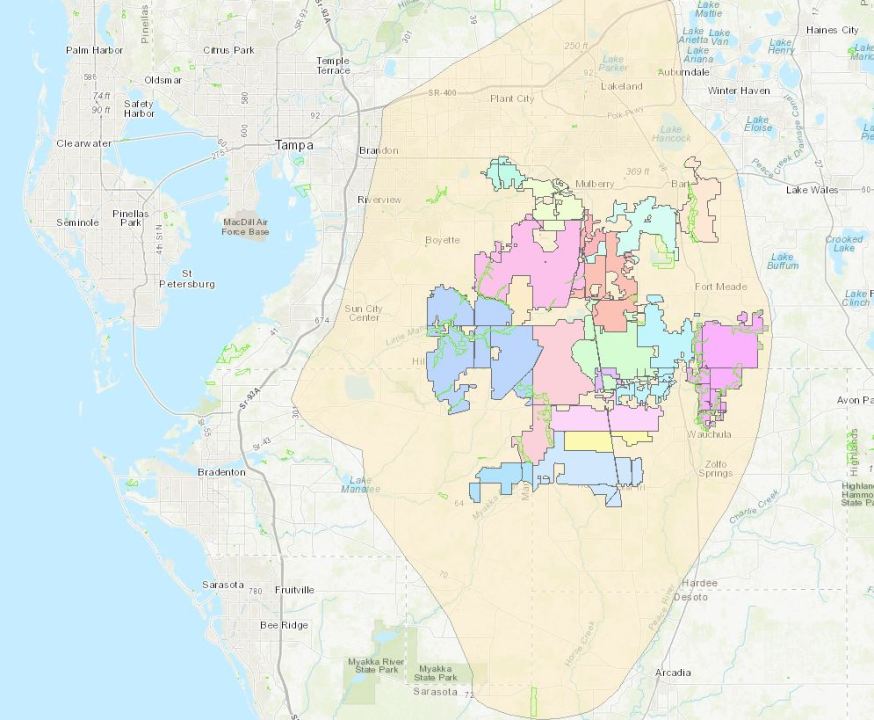MANATEE COUNTY, Fla. (WFLA) – An environmental disaster is looming on the horizon east of Tampa Bay as a phosphogypsum stack at Piney Point leaks, threatening to contaminate local water supplies.
A local state of emergency has been declared and an evacuation order issued as hundreds of millions of gallons of highly contaminated water must be drained to avoid catastrophe. But what does this all mean for people living in the Tampa Bay area?
What is a phosphogypsum stack, and why is it important?
Since 2015, the United States has been the third-largest producer of phosphorite, a phosphate-rich rock used in the production of fertilizer.
According to the U.S. Geological Survey, in 2019, Florida and North Carolina produced over 75% of the total domestic output of phosphate rock with phosphorus pentoxide, the “marketable product” used in fertilizers and feedstocks.
Phosphogypsum is the radioactive waste left over during phosphate mining, formed as a by-product from producing fertilizer, according to the U.S. Environmental Protection Agency. The waste created during the production of fertilizer is stored in large piles, or stacks. However, Manatee County officials have made it clear that the reservoir currently leaking contains mixed saltwater with elevated levels of nutrients and is acidic.
“Obviously you would not prefer to go swimming in it. There’s a little bit of ammonia in it but… we’re not talking about anything with radiation or high levels of heavy metals or anything like that,” said Interim Manatee County Administrator Scott Hopes.
In Florida, there are currently 27 stacks across the state. State officials say only nine are active. Only one of the active mines is in North Florida.
Of the stacks in Florida, 22 of them are located around the Tampa Bay area or in counties bordering the region, primarily in Bone Valley, which contains portions of Hardee, Hillsborough, Manatee and Polk counties. The majority of Florida’s active mines are in Bone Valley.

The environmental impact of phosphogypsum leaks and how it can hurt the local economy
In Manatee County, the former Piney Point phosphate plant’s phosphogypsum stack is leaking.
The Piney Point plant, closed in 2001, is still owned and maintained by HRK Holdings. The Florida Department of Environmental Protection says the company is still working to prevent the leak. On April 1, 2021, the Manatee County Commission declared a local state of emergency due to a liner tear at the site.
In 2016, a sinkhole opened in Polk County, Fla., damaging a phosphogypsum stack. The sinkhole led to an estimated 215 million gallons of contaminated, radioactive water draining into a local aquifer.
The current leak in Manatee County has the potential to do more than just harm the supply of drinking water in cities. Brian Rosegger, the owner of Lost Coast Oyster Company, told 8 On Your Side in previous coverage that he is concerned the leak will cause an algae bloom or a possible red tide, which could shut down his business.
County leadership continues to provide updates on the Piney Point facility and its ongoing leak issues, especially concerning the effects of stormwater runoff.
While the water discharged from Piney Point currently “meets water quality standards for marine waters with the exception of pH, Total Phosphorus, Total Nitrogen and Total Ammonia Nitrogen,” FDEP staff are still monitoring water quality daily, according to state officials.
Additionally, the state has released a timeline of events, clarifying the discharges that are occurring at Piney Point:
In an effort to prevent uncontrolled discharges that would result in environmental harm, DEP issued an Emergency Order requiring HRK to take immediate action and implement necessary steps to ensure integrity of the system. This authorization includes the release of controlled discharges.
To be clear, the department’s authorization for the controlled discharges is not a blanket authorization. The Emergency Final Order only authorizes discharges at an amount necessary to ensure stabilization.
The purpose of these controlled discharges is to prevent the buildup of pressure in the system. Such excess pressure could cause uncontrolled discharges of mixed seawater into freshwater, and also undermine the structural integrity of the water management system at the site.
Last night, controlled discharges alleviated pressure enough to temporarily halt uncontrolled discharges into Piney Point Creek. A State Watch Office notice was distributed regarding this event, and did not include the word “creek,” when identifying Piney Point Creek – causing many to believe all discharges had ceased which is not the case. Later on, uncontrolled discharges resumed into Piney Point Creek, but at a decreased volume. This status remains the case at this time and DEP is continuing to oversee HRK’s response onsite to resolve this issue.
Aside from this, a separate leak in the pipe leading into Port Manatee paused controlled discharges until repairs could be made. Yesterday evening, these leaks were fixed and controlled discharges resumed this afternoon in an effort to continue alleviating pressure and maintaining structural integrity.
Statement from Florida Department of Environmental Protection
Additionally, DEP says “a breakout of seepage in the east wall of the NGS South containment area was observed. This water is the same mixed seawater in the reservoir. These discharges are currently contained in the onsite lined stormwater system. DEP’s Emergency Management staff are onsite and coordinating with Manatee County to provide assistance with an engineered blockade of natural landscape to halt the breakout to contain the system.”
Potential solutions and a waiting game while officials work to contain leak
U.S. Rep. Vern Buchanan, R-Fla., who represents Manatee County and parts of Hillsborough and Sarasota counties, weighed in on the ongoing leak, calling it a potential disaster.
Buchanan posted support of a proposed “deep well injection” to dispose of liquid waste in the area going forward, but the process would take three to five years. His tweet says the Manatee County Commission voted 6-1 in favor of the concept as well.
On April 2, residents near the plant were given a notice to evacuate the area due to an “imminent uncontrolled release of wastewater.”






